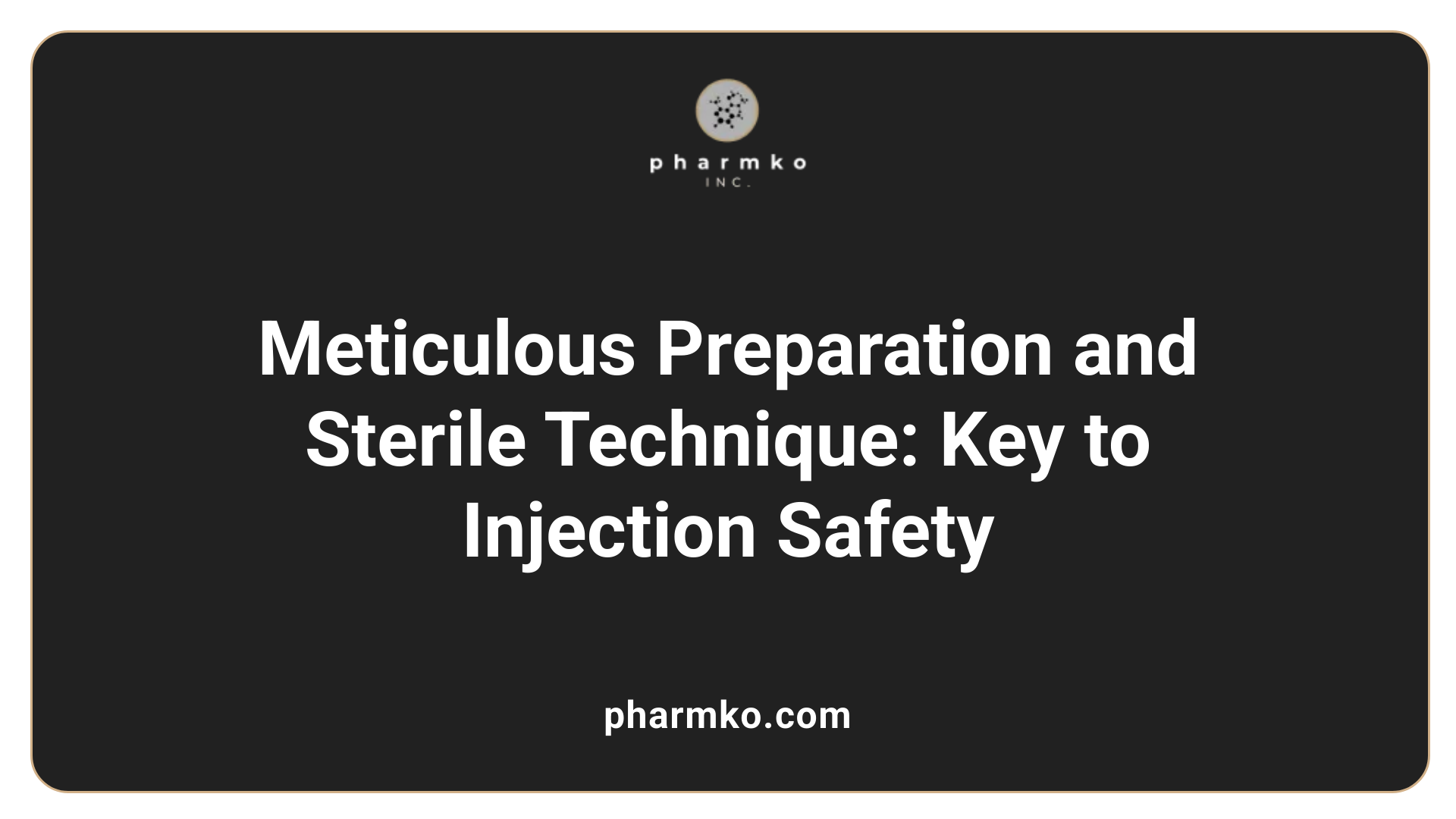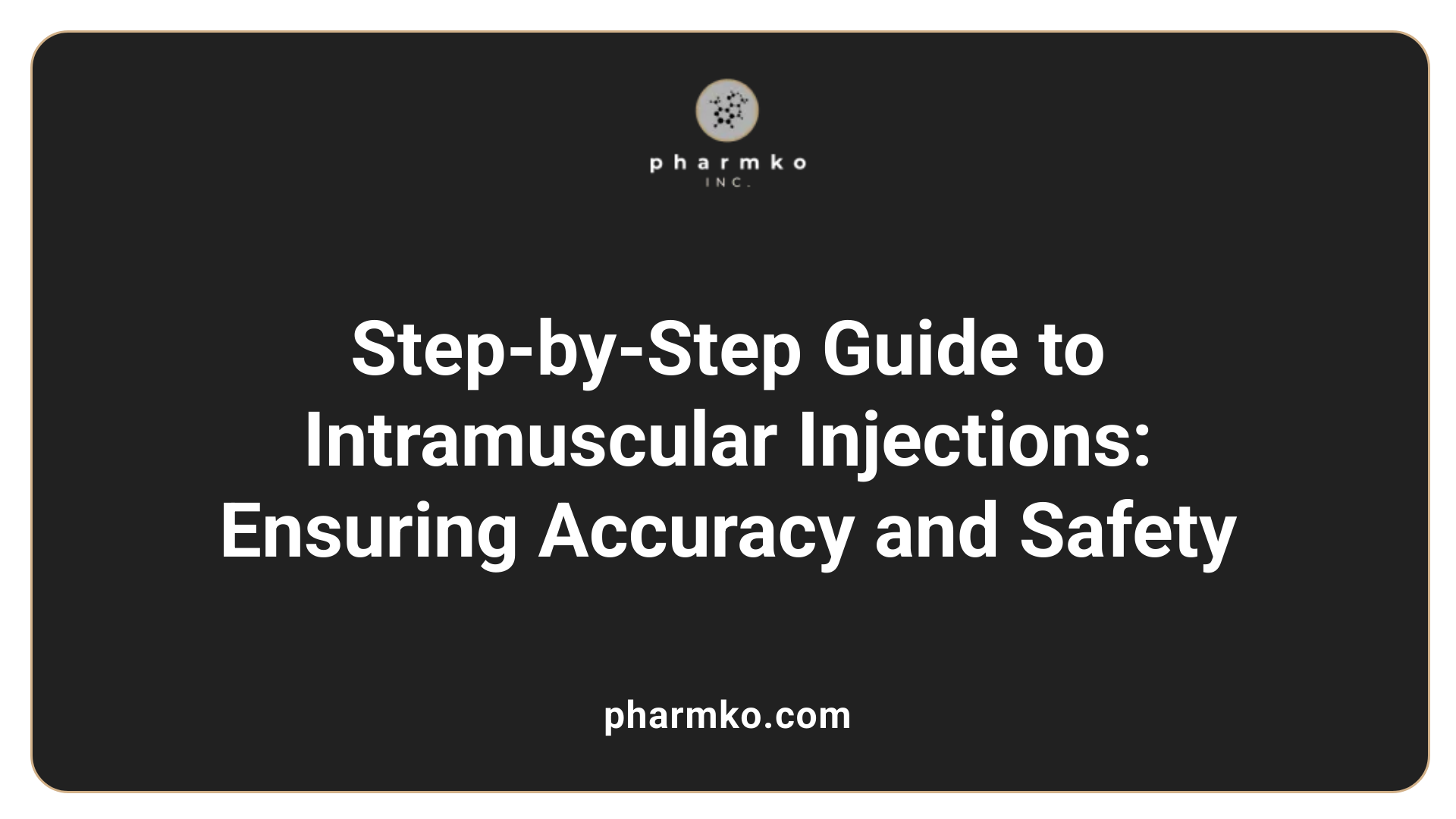Proper injection technique
Introduction to Proper Injection Techniques and Safety
Injections are crucial medical procedures used to administer medications quickly, ensure effective drug absorption, and bypass limitations of oral administration. Proper technique for injections is essential to maximize therapeutic efficacy while minimizing patient discomfort and complication risks. This comprehensive guide covers best practices, step-by-step procedures, equipment use, site selection, anatomical considerations, and safety precautions necessary for healthcare providers to perform injections safely and effectively.
Understanding the Indications for Injection and the Importance of Technique
 Injections are vital medical procedures used in several circumstances where other routes of medication administration are unsuitable or ineffective. They are administered when rapid action is required, if the drug is altered or destroyed by the gastrointestinal tract, cannot be effectively absorbed when taken orally, or when the medication is not available in an oral form. For example, emergency situations like severe allergic reactions or unconscious states often necessitate injections to deliver immediate relief.
Injections are vital medical procedures used in several circumstances where other routes of medication administration are unsuitable or ineffective. They are administered when rapid action is required, if the drug is altered or destroyed by the gastrointestinal tract, cannot be effectively absorbed when taken orally, or when the medication is not available in an oral form. For example, emergency situations like severe allergic reactions or unconscious states often necessitate injections to deliver immediate relief.
Choosing the appropriate route and technique is crucial for ensuring medication efficacy and patient safety. Proper injection practices involve meticulous preparation, aseptic techniques, correct site selection, and precise administration. The process starts with preparing equipment such as sterile syringes, needles, alcohol swabs, and medication vials. Healthcare providers must check for sterility, wash their hands thoroughly, and prepare the medication aseptically. Confirming prescription details and patient identity—including allergies—is essential before proceeding.
Safety during injections depends on verifying patient allergies, obtaining informed consent, and disinfecting the skin if contaminants are present. Proper disposal of sharps into puncture-resistant containers immediately after use is vital, along with the use of PPE like gloves when handling blood or body fluids. These practices prevent infection transmission and protect both healthcare workers and patients.
The correct technique reduces the risk of complications such as infections, incorrect site injections, nerve damage, or accidental vascular injury. Proper site preparation, such as lifting the skin fold for subcutaneous injections or locating landmarks for intramuscular sites, helps ensure accurate delivery of medication. For intramuscular (IM) injections, sites like the deltoid, ventrogluteal, and vastus lateralis are used based on patient age, size, and medication volume.
In subcutaneous (SC) injections, which involve slower absorption of drugs like insulin or anticoagulants, the outer arm, abdomen (avoiding the navel), or lateral thigh are common sites. The technique involves lifting a skin fold, inserting the needle at a 90-degree angle, and injecting slowly before withdrawing quickly. IM injections, suitable for rapid systemic absorption, require locating the right muscle—such as the deltoid or vastus lateralis—cleaning the skin, and inserting the needle at 90 degrees with a darting motion.
Incorrect technique or misidentification of injection sites can lead to adverse outcomes, including pain, hematoma, tissue damage, or nerve injury. For example, gluteal injections, if improperly administered, risk damaging the sciatic nerve. Using landmarks like the greater trochanter, acromion process, or iliac crest helps locate safe injection sites.
Choosing the correct needle gauge and length according to the patient’s age, size, and medication viscosity is essential. For example, a 22-25 gauge needle is typically used for IM injections, with longer needles favored for deeper muscle penetration in larger or obese patients.
In addition to technique, following guidelines on site rotation, site selection, and injection volume prevents tissue damage and enhances absorption. For instance, neonates and small children require smaller volumes and different sites compared to adults.
In summary, injections are indispensable in clinical practice, especially when prompt, reliable medication delivery is necessary. Adherence to proper technique, safety protocols, and site selection is vital for achieving therapeutic benefits while minimizing risks.
What are the best practices for injection safety and infection control?
Best practices for injection safety and infection control include strictly adhering to aseptic techniques, such as using sterile equipment, disinfecting the injection site with alcohol, and maintaining hand hygiene before and after procedures. It is essential to use single-dose vials whenever possible and never reuse needles, syringes, or medications from multi-dose vials on multiple patients to prevent cross-contamination and transmission of infections like hepatitis and HIV. Proper disposal of sharps in puncture-proof containers, along with immediate disposal of used needles and syringes, is critical for safety. Healthcare personnel should receive comprehensive training, conduct regular competency assessments, and follow established policies and guidelines from authorities like WHO and CDC. Additionally, utilizing safety-engineered devices, maintaining a clean environment, and promoting a culture of safety are key components to preventing infection and ensuring injection safety.
Preparing for Injection: Equipment and Sterile Technique

Gathering necessary supplies
Before administering an injection, gather all required items to ensure the process goes smoothly and safely. Essential supplies include sterile needles and syringes, alcohol wipes or antiseptic solution, sterile gauze, a cotton ball, proper medication vials or ampoules, and a sharps disposal container. Using sterile equipment for each patient minimizes the risk of infection.
Checking for sterility
Always verify the sterility of all supplies before use. Check expiration dates on medication vials and ensure that sterile packaging has not been compromised. If using multidose vials, follow proper reconstitution and storage protocols. Do not use any equipment or medication that appears contaminated or compromised.
Hand hygiene
Perform hand hygiene thoroughly before starting the procedure—either washing hands with soap and water or using an alcohol-based hand sanitizer. Hand hygiene reduces microbial transmission and protects both patient and healthcare worker.
Aseptic preparation
Use aseptic techniques throughout the injection process. Clean the patient's skin at the injection site with an alcohol wipe, wiping from the center outward in a circular motion. Allow the area to dry completely to prevent stinging and ensure disinfectant effectiveness. When drawing medication from vials, use sterile gloves if available, and handle devices carefully to avoid contamination.
Confirming prescription details
Always double-check the medication order, including the drug name, dosage, route, and specific instructions. Confirm the patient's identity through verbal confirmation and wristband checks to ensure the correct patient is receiving the medication. Documentation of the procedure, including site and medication details, should be completed according to protocol.
This preparation process is vital for safe and effective injection administration. Proper supplies, aseptic technique, and meticulous attention to detail help prevent complications such as infections or incorrect dosing.
Additional best practices
- Wear non-sterile gloves when handling blood or bodily fluids.
- Use a new, sterile syringe and needle for each injection.
- Avoid recapping needles unless necessary, and if so, use a one-handed scoop technique.
- Dispose of sharps immediately after use in a puncture-resistant container.
Following these steps ensures high standards of safety and minimizes risks associated with injections.
Injection Technique: Anatomical Landmarks and Site Selection

How do you identify proper landmarks for intramuscular injections?
Accurately locating anatomical landmarks is vital to ensure safe and effective intramuscular (IM) injections. For the dorsogluteal site, locate the posterior superior iliac spine and the greater trochanter of the femur. Draw an imaginary line between these points and identify the upper outer quadrant, which is the recommended area for injection, about 5 to 7.5 cm below the iliac crest.
For the ventrogluteal site, the key landmarks include the anterior superior iliac spine, greater trochanter, and iliac crest. Form a triangle bounded by these landmarks, with the center being ideal for injection.
The deltoid muscle, often used in adult vaccinations, is located approximately 2.5 to 5 cm below the acromion process. Identify the acromion, then mark a small, rounded area roughly 2-3 fingerbreadths below it.
Finally, the vastus lateralis site is situated in the middle third of the thigh, between the greater trochanter and the lateral femoral condyle, which can be palpated to define the site.
Ensuring correct landmarking involves palpating these structures carefully and confirming their positions before needle insertion, reducing risks of nerve injury or hitting blood vessels.
How do you choose appropriate IM sites for various patient groups?
Selecting the proper IM site depends on patient age, body size, the volume of medication, and the nature of the drug. For adults and adolescents, the deltoid muscle is preferred for small doses (up to 1 ml), such as vaccines. Its accessibility and thin muscle make it suitable for rapid administration.
The ventrogluteal site is safer than the dorsogluteal due to fewer nerves and blood vessels; it is recommended for larger volumes and adult injections.
In infants and young children, the vastus lateralis is often used because it provides a substantial muscle mass with fewer major nerves or blood vessels nearby, minimizing injury risk.
The dorsogluteal site, once common, is now avoided more frequently due to the proximity of the sciatic nerve and higher injury risk, especially if landmarks are not well identified.
How can technology aids like ultrasound enhance injection accuracy?
Ultrasound guidance is increasingly employed, especially for patients with higher BMI or difficult anatomies. It allows direct visualization of muscles, blood vessels, and nerves, thereby improving the precision of needle placement.
Ultrasound guidance reduces the risk of neurovascular injury, ensures the medication is delivered into the muscle layer, and can improve patient outcomes.
Additionally, portable ultrasound devices make this technology more accessible in various clinical settings, supporting safer, more accurate injections.
| Landmark | Location | Usage | Advantages | Notes |
|---|---|---|---|---|
| Posterior superior iliac spine | Back of the pelvis | Dorsogluteal | Familiar site, but higher risk of nerve injury | Less preferred now |
| Anterior superior iliac spine | Front of the pelvis | Ventrogluteal | Safer, lower complication risk | Recommended site |
| Acromion | Shoulder | Deltoid | Easy to locate for vaccines | Suitable for small doses |
| Greater trochanter | Thigh | Vastus lateralis | Good for infants, children | Easily palpable |
This comprehensive approach to site identification and site selection, enhanced by technological aids, helps healthcare professionals administer IM injections safely, effectively, and with confidence.
Step-by-Step Intramuscular Injection Procedure

Booking the right patient position
Proper positioning of the patient is vital for a successful intramuscular (IM) injection. The patient should be seated or lying comfortably, with the selected injection site exposed and accessible. For example, when injecting into the deltoid muscle, the patient's arm should be relaxed and slightly abducted. For the ventrogluteal site, lying on the side or supine position helps in easier landmarking. In all cases, ensure patient comfort and stability to facilitate precise needle placement. Proper positioning also minimizes patient discomfort and reduces the risk of injury.
Skin disinfection procedures
Before administering an IM injection, disinfecting the skin is essential to prevent infection. Use an alcohol-based solution, ideally 60-70%, to cleanse the designated area thoroughly. Wipe from the center outward in a circular motion to eliminate surface bacteria and contaminants. Allow the skin to air dry completely, which takes about 30 seconds. Proper disinfection not only reduces infection risk but also ensures aseptic technique, crucial for patient safety.
Needle insertion techniques
The correct angle for IM injections is typically 90 degrees, which allows the needle to penetrate directly into the muscle tissue. After preparing the site, stretch or lift the skin to stabilize the tissue. Insert the needle rapidly at the identified landmark, using a quick darting motion. For most sites, the needle should be fully inserted to ensure deposition within the muscle. When using a needle length of 25mm (1 inch), ensure the needle tip reaches the muscle layer without penetrating into the underlying structures. For the deltoid muscle, locate the acromion process, and for the vastus lateralis, locate the middle third of the thigh.
Injection speed and aspiration practices
Inject the medication slowly, approximately 1ml per 10 seconds, to minimize pain and tissue damage. In most contemporary practices, aspiration (pulling back on the plunger to check for blood return) is no longer routinely recommended for vaccines and many IM injections, except when administrating certain medications via the dorsogluteal site. When aspiration is performed, it helps confirm that the needle is not within a blood vessel, preventing inadvertent intravascular injection. After aspirating (if required), press the plunger steadily until the full dose is delivered.
Post-injection care and disposal
Immediately after injecting, withdraw the needle quickly at the same angle and gently apply pressure with sterile gauze to control bleeding or soreness. Do not rub the site; instead, press to facilitate absorption and comfort. If bleeding occurs, cover the site with a bandage. Proper disposal of sharps is crucial; dispose of the needle and syringe immediately into a designated sharps container to prevent injury and infection transmission. After disposal, activate the safety device on the needle (if available) and document the procedure with details such as site, medication, and patient reactions. Educate the patient about possible soreness or minor adverse reactions, and advise on how to monitor for any signs of complications.
Minimizing Pain and Discomfort During Injection

How can injection pain and patient discomfort be minimized?
Reducing pain and discomfort during injections involves multiple strategies centered around technique, patient comfort, and proper equipment use.
One of the most effective approaches is employing correct injection techniques. Administering the medication slowly and at a 90-degree angle helps minimize tissue trauma and reduces pain. Carefully selecting the appropriate needle gauge and size is crucial; smaller gauges (like 25G) and shorter needles typically cause less pain, especially when injecting into smaller or less fatty areas.
Pre-treatment measures can further ease discomfort. Applying a cold pack wrapped in a cloth to the injection site before the procedure can numb the area temporarily. Warming the medication to room temperature can prevent cold-induced pain, making the process more tolerable.
Site rotation is vital in preventing tissue irritation, scarring, or lipodystrophy. Choosing a site with adequate subcutaneous fat, such as the outer arm or abdomen, reduces the likelihood of hitting bones or nerves and lessens pain.
Patient education plays a key role. Explaining the procedure beforehand, including what to expect, helps alleviate anxiety. Psychological support techniques like guided imagery or distraction methods can distract patients from the injection process.
For patients with needle phobia, devices like autoinjectors, which deliver the medication quickly and with minimal handling, can significantly reduce fear and discomfort. Employing topical anesthetics or numbing creams is also beneficial, especially in pediatric or highly sensitive individuals.
Overall, combining gentle technique, patient-centered approaches, and appropriate equipment use creates a more comfortable and less painful experience, encouraging better adherence and making injections less intimidating for patients.
Equipment Use, Needle Selection, and Safe Disposal
What equipment is necessary for injections and how should it be used properly?
Performing injections safely and effectively requires specific equipment and adherence to proper procedures. Essential items include sterile syringes and needles of suitable size and gauge, alcohol swabs for disinfecting the skin, and designated sharps disposal containers for safe discard of used needles and syringes.
Before administering an injection, inspect all equipment thoroughly. Ensure that the packaging is intact and that there are no damages to the syringe or needle. Always use new sterile supplies for each injection to reduce the risk of infection and cross-contamination.
Skin disinfection is a critical step. Use alcohol swabs to thoroughly clean the injection site with an outward motion, starting from the center and moving outward, and allow the skin to air dry completely. The choice of site and the cleaning technique depend on the type of injection, whether intramuscular, subcutaneous, or intradermal.
During the injection process, observe aseptic techniques. Perform hand hygiene before starting, wear gloves when appropriate, and ensure the correct angle of insertion—usually 90 degrees for intramuscular and subcutaneous injections. All equipment used should be disposable—single-use needles and syringes should not be reused.
After the injection is completed, pressure can be applied to the site with a sterile gauze or cotton ball if needed to prevent bleeding. Proper disposal of sharps is crucial. Immediately place used needles and syringes into approved sharps containers, which should be leak-proof, puncture-resistant, and labeled for biohazard waste.
Proper disposal procedures not only protect healthcare workers and patients from needlestick injuries but also prevent environmental contamination. When the sharps container is three-quarters full, replace it with a new one and follow local regulations for waste handling.
Adhering to these equipment use guidelines ensures safe, hygienic, and effective injection practices while minimizing risks of complications and injuries.
Optimal needle gauges and lengths for IM injections
Selecting the correct needle gauge and length is essential to ensure the medication reaches the muscle tissue without seepage into subcutaneous fat or injury to surrounding structures.
For intramuscular injections, needle gauges typically range from 22 to 25. Larger gauges (such as 21G or 22G) are used when the medication is viscous or when a larger volume needs to be injected. The length of the needle depends on the patient's age, size, and skin thickness but usually falls between 25 mm (1 inch) and 38 mm (1.5 inches).
In adult patients, a common choice is a 23G or 25G needle with a length of 25mm to 38mm, inserted at a 90-degree angle. For children and smaller individuals, shorter needles (such as 16mm to 25mm) are preferable.
Understanding these selections helps to ensure proper vaccine delivery and medication effectiveness, while minimizing discomfort and risk.
Handling and reconstitution of medications
Accurate handling and reconstitution are vital for medication efficacy and patient safety. Always start with a thorough hand hygiene routine and wear gloves when drawing medication.
If medications come in ampoules, flick the top to drain any residual fluid, then carefully snap off the top along the scored line, ensuring no glass shards fall into the solution. Use an alcohol swab to clean the neck of the ampoule before opening.
For vials, disinfect the rubber stopper with an alcohol wipe before inserting the needle. Draw air into the syringe equal to the volume of medication needed, then insert the needle into the vial's stopper and inject the air. Turn the vial upside down and draw the prescribed dose.
When reconstituting powders, follow manufacturer instructions precisely for diluent volume and mixing method. Avoid shaking vigorously to prevent foaming or damaging the medication.
Always check the final solution for clarity, absence of particulates, and correct volume before drawing into the syringe for administration.
Disposal procedures for sharps
Safe disposal of sharps is a legal and ethical requirement aimed at preventing injury and infection.
Immediately after use, activate any safety features on the needle if available, then carefully discard the needle and syringe into an approved sharps container. These containers should be leak-proof, puncture-resistant, and clearly marked for biohazard waste.
Do not recap needles unless absolutely necessary; if recapping is needed, use a single-handed scoop technique to avoid needlestick injuries.
When the sharps container is three-quarters full, seal it securely and follow local regulations for disposal. Do not overfill or attempt to empty or reuse sharps containers.
Transport the filled container to designated disposal locations and follow institutional protocols for biomedical waste management.
The proper management of sharps waste protects healthcare workers, patients, and the community from unnecessary risks.
Post-Injection Procedures and Patient Education
Applying pressure and bandaging small bleeding
After administering an injection, it is essential to apply gentle pressure to the injection site with a sterile gauze or cotton ball to stop any bleeding. If bleeding persists, maintain pressure until it subsides. For small bleeding, a bandage can be applied to protect the area and absorb any residual blood. Proper bandaging helps prevent infection and provides comfort to the patient.
Monitoring for adverse reactions
Patients should be observed for immediate adverse reactions following injection. Common reactions include pain, swelling, redness, or itching at the site. Severe reactions, such as allergic responses, can manifest as rash, difficulty breathing, or facial swelling. Healthcare providers must be prepared to recognize and manage anaphylaxis promptly by administering emergency medication and seeking urgent medical help.
Patient instruction on site care and possible side effects
Patients should be advised to keep the site clean and dry. They should watch for signs of infection like increasing redness, warmth, swelling, or pus. Patients must also be informed about common side effects like soreness or mild swelling, which usually resolve within a few days. If pain or other symptoms worsen or do not improve, they should seek medical advice.
It is recommended to avoid strenuous activities and massaging the area immediately after the injection. Patients should report if they notice unusual symptoms such as persistent pain, lumps, or skin discoloration.
Documentation and reporting
All injection procedures must be properly documented in the patient’s medical record. This includes recording the date and time of administration, site, medication name and dose, lot number, and any patient reactions. If adverse effects or errors occur, they must be reported according to institutional protocols for safety and quality improvement.
Common sites for intramuscular injections
Understanding proper site selection is crucial for effective and safe medication delivery.
| Site | Landmark | Suitable For | Notes |
|---|---|---|---|
| Deltoid muscle | Below the acromion process, 2-3 finger widths below | Vaccines, small volume medications | Not suitable for large volumes; easily accessible |
| Ventrogluteal site | Greater trochanter, anterior superior iliac spine, iliac crest | Adults, children > 7 months | Safer, reduces nerve injury risk |
| Vastus lateralis | Middle third of the thigh, between greater trochanter and lateral condyle | Infants, self-injectors | Good for all ages, easy to locate |
| Dorsogluteal | Upper outer quadrant of buttock | Less preferred due to nerve injury potential | Avoid if possible, due to sciatic nerve risks |
How do you identify the proper site for intramuscular injection?
Locating the correct injection site involves identifying anatomical landmarks carefully:
- For the deltoid, locate the triangle formed about two finger-widths below the acromion process.
- For the vastus lateralis, divide the mid-thigh into three parts and choose the outer middle section.
- For the ventrogluteal, place the heel of your hand on the greater trochanter with fingers pointing toward the head, and inject in the middle of the V formed by your fingers. Proper site identification helps minimize complications like nerve injury, improper absorption, and injection site reactions.
What guidelines are available for nurses for intramuscular injection techniques?
Nurses should follow standardized procedures that emphasize site selection, patient positioning, aseptic technique, and injection technique:
- Use proper anatomical landmarks to identify injection sites.
- Ensure hand hygiene and wear gloves.
- Clean the skin with an alcohol swab and allow it to dry.
- Use the appropriate needle size (typically 22-25 gauge, length depending on patient size and site).
- Insert the needle at a 90-degree angle swiftly to reduce discomfort.
- Inject slowly to minimize pain.
- Aspirate if protocol dictates, especially in dorsal gluteal injections.
- Use the Z-track method to prevent medication leakage.
- Immediately dispose of used needles in a sharps container.
- Document the procedure details accurately. Following these guidelines helps reduce risks and enhance safe, effective medication delivery.
Conclusion: Ensuring Safety and Effectiveness in Injections
Mastering proper injection technique is vital for healthcare providers to deliver safe, effective, and comfortable care. By understanding the indications, adhering to infection control practices, accurately locating anatomical landmarks, selecting appropriate equipment, and following a step-by-step procedure, practitioners can minimize complications and maximize drug efficacy. Consistent site rotation, patient education, and meticulous disposal practices further enhance safety and patient satisfaction. Continual training and adherence to established guidelines are essential to uphold high standards in injection procedures, ultimately improving patient outcomes and reducing risks.
References
- [PDF] Injection Techniques Clinical Skills Guidance
- Nursing guidelines : Intramuscular Injections
- Giving an IM (intramuscular) injection - MedlinePlus
- Best practices for injection - NCBI
- [PDF] Step-by-step guide Intramuscular Injections
- [PDF] Immunization Technique for Intramuscular (IM) Injections – Deltoid ...
- Intramuscular injection: Locations and administration
- 7.4 Intramuscular Injections - BC Open Textbooks
- Intramuscular Injection - StatPearls - NCBI Bookshelf
- How to Give a Subcutaneous Injection - Johns Hopkins Arthritis Center













